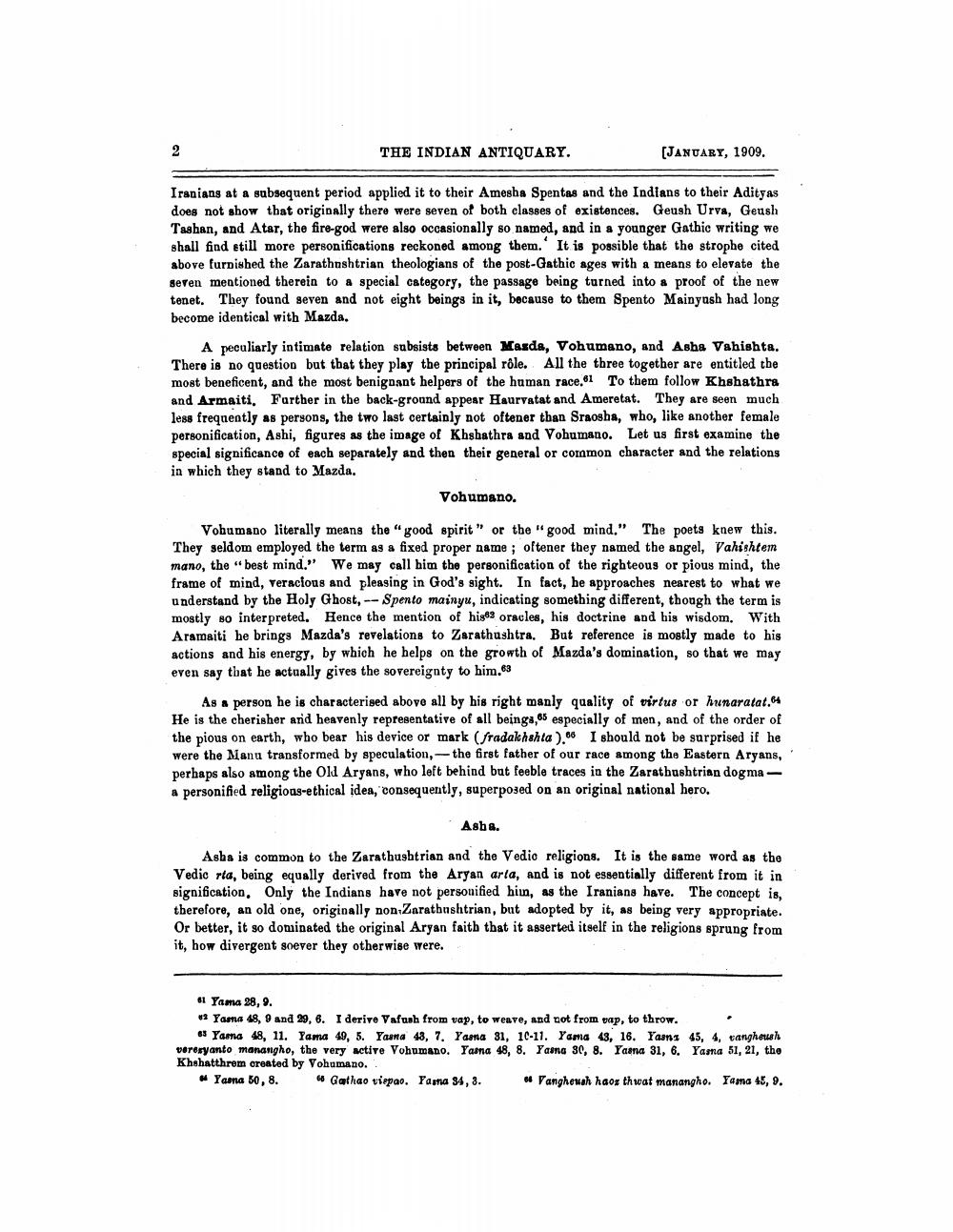________________
THE INDIAN ANTIQUARY.
(JANUARY, 1909.
Iranians at a subsequent period applied it to their Amesha Spentas and the Indians to their Adityas does not show that originally there were seven of both classes of existences. Geush Urva, Geush Tashan, and Atar, the fire-god were also occasionally so named, and in a younger Gathic writing we shall find still more personifications reckoned among them. It is possible that the strophe cited above furnished the Zarathnshtrian theologians of the post-Gathic ages with a means to elevate the seven mentioned therein to a special category, the passage being turned into a proof of the new tenet. They found seven and not eight beings in it, because to them spento Mainyash had long become identical with Mazda.
A peculiarly intimate relation subsists between Masda, Vohumano, and Asha Vahishta. There is no question but that they play the principal rôle. All the three together are entitled the most beneficent, and the most benignant helpers of the human race.61 To them follow Khshathra and Armaiti. Further in the back-ground appear Haurvatat and Ameretat. They are seen much less frequently as persons, the two last certainly not oftener than Sraosha, who, like another female personification, Ashi, figures as the image of Khshathra and Vohumano. Let us first examine the special significance of each separately and then their general or common character and the relations in which they stand to Mazda.
Vohumano.
Vobumano literally means the "good spirit" or the "good mind." The poets knew this. They seldom employed the term as a fixed proper name ; oftener they named the angel, Vahishtem mano, the best mind." We may call him the personification of the righteous or pious mind, the frame of mind, veracious and pleasing in God's sight. In fact, he approaches nearest to what we understand by the Holy Ghost, --Spento mainyu, indicating something different, though the term is mostly so interpreted. Hence the mention of hig82 oracles, his doctrine and his wisdom. With Aramaiti he brings Mazda's revelations to Zarathushtra. But reference is mostly made to his actions and his energy, by which he helps on the growth of Mazda's domination, so that we may even say that he actually gives the sovereignty to him.63
As a person he is characterised above all by his right manly quality of virtus or hunaratat.64 He is the cherisher and heavenly representative of all beings,65 especially of men, and of the order of the pious on earth, who bear his device or mark (fradakhshta). I should not be surprised if he were the Manu transformed by speculation, the first father of our race among the Eastern Aryans, perhaps also among the Old Aryans, who left behind but feeble traces in the Zarathushtrian dogma - a personified religious-ethical idea, consequently, superposed on an original national hero.
Asba.
Asha is common to the Zarathushtrian and the Vedic religions. It is the same word as the Vedio rta, being equally derived from the Aryan arla, and is not essentially different from it in signification, Only the Indians have not personified hiun, as the Iranians have. The concept is, therefore, an old one, originally non, Zarathushtrian, but adopted by it, as being very appropriate. Or better, it so dominated the original Aryan faith that it asserted itself in the religions sprung from it, how divergent soever they otherwise were.
61 Yama 28, 9. 11 Yama 48, 9 and 29, 6. I derive Vafush from vap, to weave, and not from vap, to throw.
o Yama 48, 11. Tama 49, 5. Yauna 43, 7. Yasna 31, 10-11. Yama 43, 16. Yaani 45, 4, tanghouh vorexyanto manangho, the very active Vohumano. Yamna 48, 8. Yasna 30, 8. Yasna 31, 6. Yasna 51, 21, the Khshatthrem created by Yohumano..
" Yama 50,8. Gathao viopao. Pama 34, 3. Panghouah haox thwat manangho. Fama 45, 9.




